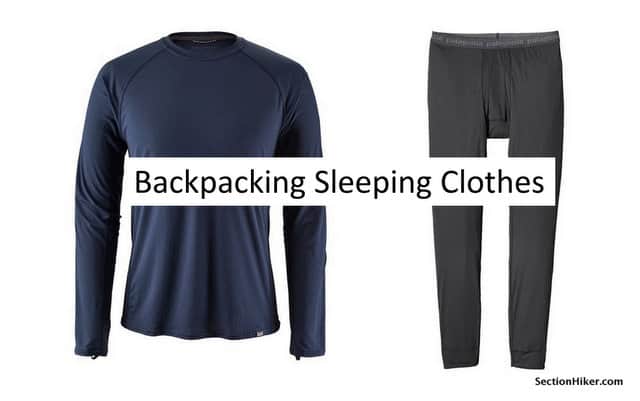I carry a separate set of clothes to sleep in on backpacking trips because it feels nice to put something on that's clean after perspiring in my regular daytime hiking clothes. They also serve double duty as an extra baselayer in cold weather or if I need to change into something dry after my regular clothes get wet, like when I have to hike in rain.
Wool or synthetic, it doesn't really matter what kind of fabric they're made of, although you probably want to avoid cotton unless you're backpacking through a hot and dry climate like the desert where they can dry quickly if they get wet. I use a long sleeve synthetic jersey and long underwear (Lightweight Patagonia Capilene) because they won't shrink in a dryer and they basically last forever. They also pack up small and are very lightweight. I also send them out for Insect Shield Treatment because they're my baselayer when I sleep in a hammock, usually deep in the woods, in tick territory.
I also change into a relatively clean and dry pair of hiking socks each night and wear a fleece beanie cap, since I usually sleep in a hoodless sleeping bag if I'm on the ground or with a quilt, in a hammock.
Psychological benefits
While wearing sleeping clothes will help you keep your sleeping bag/quilt and sleeping pad cleaner, there's more to wearing sleeping clothes than meets the eye. When I take off my daytime clothes and switch to my sleeping clothes, I relax. It triggers a psychological response and helps me kick back in preparation for sleep. I sleep really well outdoors and feeling "cleaner" has a lot to do with it. My daytime hiking clothes get crusty with salt, sweat, and dirt, and they'd be nasty to sleep in. While I wear a thin shirt and pants that I rinse and will usually dry (mostly) overnight, they're wet when I go to sleep.
Health benefits
There are also health benefits to sleeping in cleaner and drier clothes at night, because they give your nether regions and feet a chance to gently reabsorb body fluids and heal. If you sleep in your salt-encrusted daytime hiking clothes at night, even if it's just your boxers, the salt will continue to draw moisture from your skin. Wearing clean clothes and socks will reduce any ongoing irritation and help your recover its natural resiliency. Plump, resilient skin is much more durable, blister, and chafe-resistant than dry irritated skin.
Sleeping naked
What about sleeping naked on backpacking trips? Whatever floats your boat. I'd still recommend bringing along an extra baselayer shirt and long underwear that you can layer with if you get cold or wet, or you can use to augment your sleeping bags/quilts warmth on cold nights. I don't bring any extra daytime shirts, pants, or underwear on my backpacking trips, so my sleeping clothes are my only fall backs.
See Also:
- Backpacking Clothing System for 3 Season Hiking and Backpacking
- How Many Pairs of Socks Should You Bring on a Backpacking Trip?
- Wool vs. Synthetic: Which is the Better Baselayer?
- Is it Warmer to Sleep Naked in a Sleeping Bag?
The post Backpacking Sleeping Clothes appeared first on Section Hikers Backpacking Blog.
from Section Hikers Backpacking Blog https://ift.tt/2OBzx9D

No comments:
Post a Comment